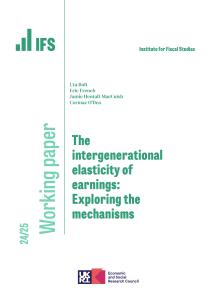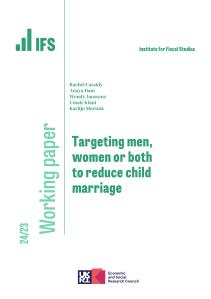The Augar Review of Post-18 education is the first comprehensive review of both the Further Education (FE) and Higher Education (HE) sectors and has been eagerly awaited. This note provides our immediate reaction.
Much needed increase in focus on FE
The review recommends several changes to FE, including:
- restoring the right to free level 2 and 3 qualifications;
- overhauling and simplifying provision of level 4 and 5 qualifications with the aim of increasing take up significantly;
- Match loan funding for students doing level 4 and 5 qualifications in FE to same level as HE loans;
- A £1 billion capital injection into the FE system;
- A new workforce strategy aimed at improving pay in FE which has fallen behind other parts of the education system;
This follows a long period during which spending on FE has been heavily squeezed relative to spending on schools and HE over a long period, as we have shown previously (see Figure 6.1b).
Taking back control of HE spending
Perhaps the biggest headline on the HE side is the recommendation of a reduction in tuition fees to £7,500 per year, from their current level of £9,250. The review’s justification for this draws heavily on IFS research which highlighted that under the current system the vast majority of government spending on higher education is through unpaid student loans, which results in the government having very little control over how its spending is distributed. Government spending is implicitly much higher for subjects where earnings of the graduates are low, which is a feature of the system which may not align with the government’s objectives.
Crucially, Augar recommends that the funding gap caused by the fee cut is filled by teaching grants, meaning the government would make up the difference of £1,750 per student per year. The sector will probably breathe a sigh of relief that per-student funding would not be facing an immediately cut, although some courses will be under threat. The major advantage from Augar’s point of view is that it gives the government more freedom to control spending – it would have close to £2 billion a year in grants to distribute as it sees fit. Augar hopes that this will ultimately reduce the incentives for universities to push cheap-to-teach courses, on which they currently make the biggest margins.
One might expect that the main disadvantage of this would be a high cost to government. In practice it will only cost around £500 million a year – considerably less than £1,750 multiplied by the number of students. That’s because a large fraction of those loans would not be repaid anyway. The main effect is in fact some loss of progressivity, as it is only the highest earnings graduates who would repay the final chunk of the tuition fee loans.
Bringing back maintenance grants (again) and reducing interest
Augar also takes a swipe at two of the more unpopular issues with the system. First, he recommends the return of maintenance grants of at least £3,000 per year. These are cash transfers to students coming from poorer households which were scrapped (and replaced with loans) by the coalition government in 2015. This would be the second flip-flop on this specific issue, as grants were scrapped in 1998 only to be re-introduced in 2004.
Together with the cut in fees, this policy will reduce the debts of the poorest students on graduation (although Augar urges that we refrain from using such language) by around a third, down from almost £60,000, for those coming from the poorest households. It would spell an end to the current situation of the poorest students graduating with largest student debts (because they get more maintenance loans).
It is important to note that while this policy benefits students from poorer households it is only those from such backgrounds who go on to earn high salaries who benefit in terms of reduced repayments. Again, the cost of this is equal to the lost future repayments of graduates, which once the fee cut is taken into account would be roughly another £500 million (assuming the grants look approximately the same as the ones that were in place in 2015).
Second, he recommends a cut in interest rates on student loans during study, from RPI + 3% to just RPI. As he acknowledges, many will be disappointed not to see a plan for the positive rates after leaving education to be scrapped as well, but Augar considers this too expensive. The removal of the positive rate over RPI during study would cost around £300 million after adjusting for the lower fees and maintenance loans and yet again would benefit the highest earners the most.
Squeezing money from HE
The Review’s remit was somewhat constrained by the need to propose reforms without spending any more money. The changes to HE so far would cost well over £1 billion a year if they were implemented for the cohort of students starting HE in September this year (in practice, it is recommended that the changes are not brought in until September 2021). Combined with the increased FE spend this demanded an extra £2 billion.
The first solution proposed is that current HE funding is frozen in nominal terms until 2022/23. This would bring per-student funding down from its 2012 peak by 13% in real terms. It would also mean that much of the funding increase resulting from the 2012 reform will have been eroded by 2022/23, meaning per-student funding will be only around 15% higher under the new system than it would have been had there been no reforms since 2011 (assuming funding would have been kept constant in real terms).
However, this doesn’t cover the additional costs, and so the review turns to the HE student loan repayment rules. Several options for extracting repayments from the highest earners are discussed, but in the end the outlined solution is to reduce the repayment threshold by 8% to around £23,000 in today’s money and extend the repayment period by 10 years to 40 years from graduation. Many graduates will therefore be repaying their student debts into their sixties. To address concerns that this will create a system whereby the very highest earning graduates repay less than middle earning graduates, a repayment cap of 1.2 times the real value of the loan is also proposed.
Augar estimates that all the changes to HE combined result in a saving of half a billion pounds. However, the changes hit middle and lower earning graduates the most, while actually reducing repayments of the very highest earners. As highlighted in Figure 6.11 of the review, this generates a rather regressive overall package of proposed changes – the top 20% of earners would see reductions in their lifetime repayments by around 30%, while everyone between the second and seventh decile will see increases in lifetime repayments. Of course, the overall system would remain very progressive with high earning graduates paying back much more of the cost of their degree than low earners.
The reforms proposed by the Augar review would represent yet more changes to a student loan system that has been already been heavily tinkered with. The review highlights the need for students to be better informed about the nature of the loans, yet the changes add even more complexity to a system that is already very difficult for prospective students and their parents to understand.











